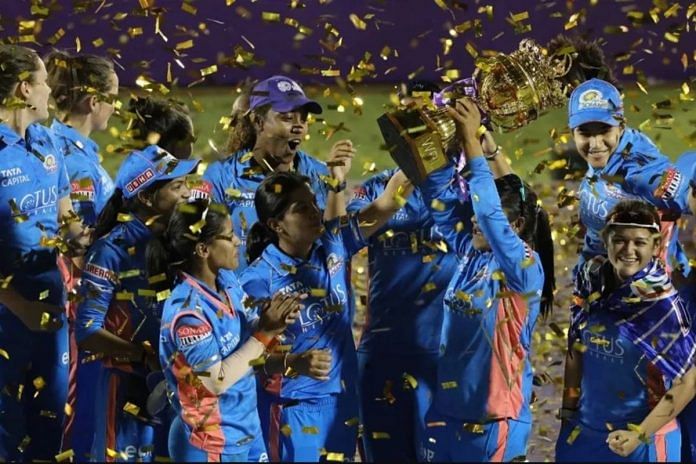Hours before Mumbai Indians skipper Harmanpreet Kaur became the first captain to win the inaugural Women’s Premier League, the Brabourne Stadium was consumed with roaring chants of “Sachin… Sachin… Sachin…Sachin”. But it was before the camera panned on the ‘Little Master’ sitting in the VIP box. Just as Delhi Capitals’ Alice Capsey played off Issy Wong’s full toss delivery into Kaur’s hands in the first innings, the third umpire Paschim Pathak was summoned. He asked for replays on microphone, while the audience wondered if Tendulkar had slipped into the TV umpire’s seat. The chants grew louder when Sachin Tendulkar was shown on screen few seconds later.
Besides the uncanny resemblance between Pathak and Tendulkar’s voice, the first edition of Tata WPL, which concluded on 26 March, was sprinkled with notes of ‘historic’ umpiring moments and some avoidable commentary.
On 16 March, during a league stage match between Delhi Capitals and Gujarat Giants, commentator Sanjay Manjrekar said that he does not know much about Taniya Bhatia who was batting on the field, and urged his co-commentator Anjum Chopra to speak more about her. An indicator of the amount of catching up women’s cricket has to do when it comes to popular appeal. Rarely does one witness such moments in men’s games.
“It is just the question of the fact that it is a cricketer who you are not seeing that much of. I don’t think it is out of disrespect but since Anjum Chopra has covered a lot more women matches and has been a player of some repute, she naturally would know more,” says Sharda Ugra, sports writer and expert.
Cricket analyst Ayaz Memon offers another perspective while agreeing with Ugra.
“One way to look at it is that the commentator was honest that Anjum would know more than he does. That’s not a bad sign. But obviously, one must know the players just as you need to know the game’s rules,” he says. Considering that it was the first time that WPL was being played, a lot of these names were not easy on the tongue of the commentator, adds Memon, unless you are a woman cricketer yourself or have met these players earlier.
While Ugra acknowledges the lack of preparation on commentators’ part, she says there are bigger concerns than ill-preparedness of commentators that marred the WPL.
“Things get amplified because of social media into bigger issues than they are. The grounds and boundaries are much smaller than elsewhere in other women’s cricket leagues. I think that’s more insulting to the women that are playing rather than what is being said over commentary,” she adds.
In England, BBC TMS Radio made a point that all the top male commentators watched women’s matches as well. They got to know the players, their style, strength and so on. Whether that happened in a sustained and organised way for WPL is not known, according to Ugra.
Incorrect pronunciation of players’ name (in Hindi) and usage of the term ‘batsman’ instead of ‘batter’, as mandated by International Cricket Council, found their way on live television, suggesting the ignorance at play. While terms like ‘bowler’, ‘wicket keeper’ and ‘fielder’ are gender neutral, until recently, ‘batsman’ was the term used for cricketers batting on the pitch.
In September 2021, the MCC declared that it would be moving away from the term ‘batsman’ to ‘batter’ in the Laws of Cricket. A month later, the International Cricket Council (ICC) followed suit. ICC CEO Geoff Allardice described the “small” change as an “overdue evolution” as the batters are gender-neutral. He further said that the move would have a “significant impact” in making the sport more inclusive.
“I would just put that down to habit and not disrespect. It is only recently that it has been made compulsory to not use ‘batsman’ or ‘batswoman’. It is just an error that creeps in,” says Ugra, noting that the women sitting around cricket personalities would be able to call out sexism if they see it.
Memon also echoes Ugra’s observation.
“Conventionally, those who have been doing commentary have been using ‘batsman’ and they sometimes lapse into that again. But this is something which has to be ingrained among the commentators and writers,” says Memon.
The 22 matches played during maiden WPL were streamed live on JioCinema with commentary in English, Hindi, Telugu, Tamil and Kannada.
Also read: What makes Nathan Lyon lethal in India? It’s the pitches Shane Warne didn’t get and more
Umpires steal the show
While the commentary had its ups and downs, the umpiring was one of the highlights of the women’s cricket league.
While Paschim Pathak received love from the audience for his eerie resemblance to Sachin Tendulkar’s voice, Vrinda Rathi impressed spectators with her celebratory hand gestures while signalling a boundary. Rathi also happens to be the first Indian woman on-field umpire to officiate an international cricket match during the Women’s T20 World Cup in South Africa in 2023.
Among the 14 umpires (on-field and TV) and referees — all Indian — six were female. Vrinda Rathi, Nitin Pandit, Chirra Ravikanthreddy, N Janani, Gayathri Venugopalan, Sanjay Kumar Singh, Madanagopal Kuppuraj, Saurabh Dhote, Rajni Basnet, Paschim Pathak, Ranjeev Sharma, GS Lakshmi, Anupa Narvekar, and Varsha Nagre were the ones assigned to officiate the matches being played at two venues across Mumbai — Brabourne Stadium and Dr. DY Patil Stadium.
The final match played on Sunday was the only fixture to have two women (N Janani and Vrinda Rathi) on-field umpires. The tournament in itself is historic as women cricketers fought for more than a decade to get it on the floors.
“There are many loopholes with not enough teams and smaller boundaries. But the league is on and you cannot turn the clock back on it,” says Ugra, describing the moment of watching a male and female umpire walk out together on the field as “historic” in Indian cricket.
(Edited by Anurag Chaubey)



